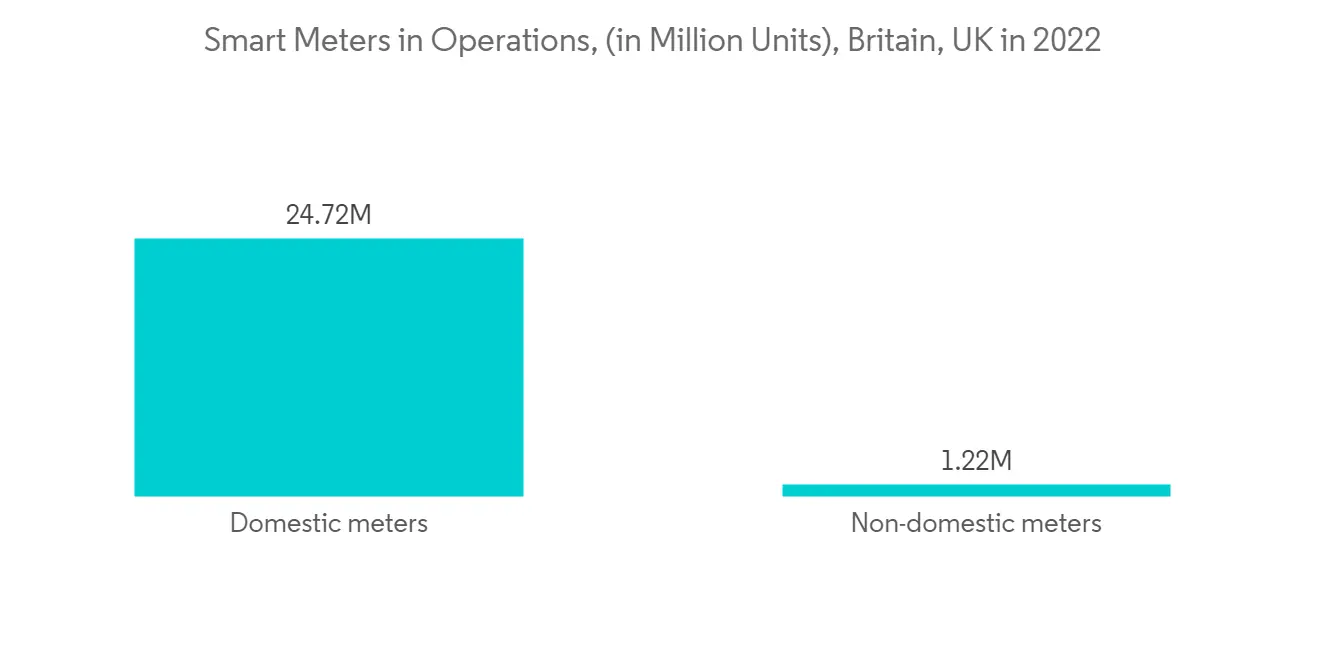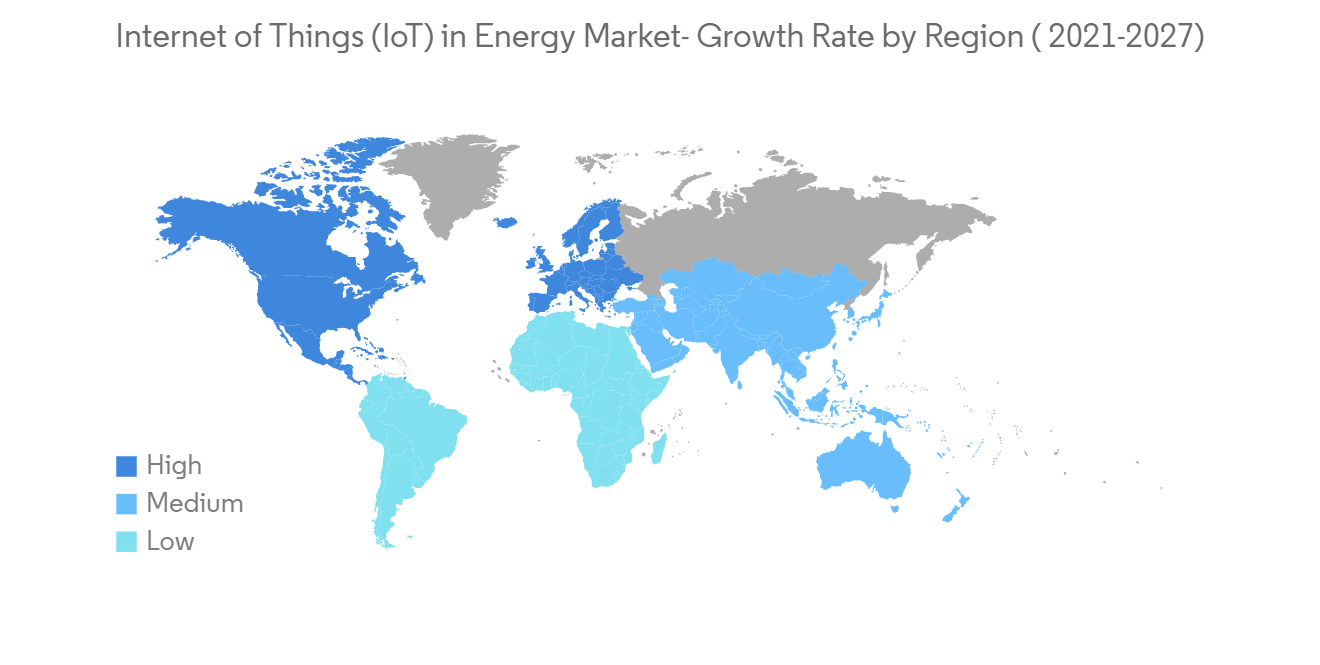 |
市場調查報告書
商品編碼
1273370
能源市場中的物聯網 - 增長、趨勢和預測 (2023-2028)Internet of Things in Energy Market - Growth, Trends, and Forecasts (2023 - 2028) |
||||||
※ 本網頁內容可能與最新版本有所差異。詳細情況請與我們聯繫。
在預測期內,能源物聯網預計將繼續以 10% 的複合年增長率增長。
根據國際能源署的說法,作為現代生活的關鍵推動因素,能源部門對全球和國家的應對和恢復工作也至關重要,儘管它受到了 COVID-19 大流行的嚴重影響。我認為是這樣。
主要亮點
- 物聯網 (IoT) 預計將對能源行業產生重大影響。從使用傳感器的室溫監控到控制整個建築物能源使用的複雜應用,物聯網可以幫助降低成本。
- 組織可以獨立監控機械、照明、供暖和空調系統等設備。分析來自 IoT 設備的數據並製定策略以提高效率。物聯網解決方案還有助於系統的遠程控制和協調,以確保盡可能高的能源生產效率。
- 隨著產生能源的自然資源日益減少和能源浪費不斷增加,減少能源浪費的創新解決方案和採用可提供高效率的解決方案在世界範圍內受到越來越多的關注。
- 預測分析網絡監控來自嵌入電網的傳感器的數據。因此,機器可以減少能量傳輸和分配損失,從而使能源消耗在全球範圍內變得高效且具有成本效益。
- Nexus Solutions 等公司提供監控和減少建築能耗的互聯解決方案。Aquicore 還在開發一個連接到已安裝的電能表的分析平台,使組織能夠做出提高員工生產力和減少能源浪費的決策。
- 然而,將新的可持續分佈式能源 (DER) 整合到旨在分配集中產生的能源的現有電網中是一項重大挑戰。
- 從支持室溫監測的傳感器到遠程管理能源使用,物聯網在大流行期間使能源部門受益,實現了可持續發展和成本節約。此外,儘管政府出於對員工安全的擔憂而關閉,但一些物聯網系統已經實現了可再生能源的使用,減少了污染並使用了不可再生資源。公司得以繼續運營。在大流行期間,該行業的公司已經為他們的大部分業務啟用了物聯網遠程工作。
物聯網能源市場趨勢
智能電錶有望佔據較大份額
- 近年來,智能電錶一直是公用事業公司採用最多的物聯網設備之一。這些設備將建築物與智能電網互連,使這些公司能夠更有效地管理能源流動。智能城市也在使用智能電錶。
- 支持物聯網的智能儀表使企業能夠訪問豐富的實時數據,以降低成本、提供更好的服務並增加利潤。它還有助於有效平衡電力負載、最大限度地減少停電、通過更準確的預測實現更高效的能源分配,以及根據實時需求提高或降低成本來實現動態定價。
- 通過升級智能電錶和電網,許多政府也在尋求利用物聯網來推動各地區綠色能源生產的增長。例如,美國能源部正在尋求能夠促進綠色能源使用,同時大幅降低成本的智能電網。這些因素促使能源公司投資物聯網技術以跟上其他人的步伐。
- 智能計量技術使公用事業公司能夠使用來自智能儀表的準確實時數據提供有用和詳細的能源消耗反饋,提高每月能源賬單的透明度,並根據使用情況提供準確的賬單。您還可以讓您的客戶做出更明智的決策他們的能源使用,例如定價。這些優勢正在推動市場的增長。

北美將實現最高增長
- 隨著物聯網在該領域發揮更大作用,預計北美將成為智能能源項目部署驅動的重要市場。此外,整個行業的快速數字化和技術進步正在推動該地區物聯網的發展。
- 美國和加拿大是大數據、物聯網和移動等技術的早期採用者,為物聯網市場創造了巨大的增長機會。這些國家建立了強有力支持研發活動投資的經濟體系。此外,與其他地區相比,該地區的創業文化發展更快。
- 此外,該地區擁有強大的物聯網供應商立足點,為市場增長做出了貢獻。其中包括IBM Corporation、Microsoft Corporation、Intel Corporation、Cisco Systems Inc.、Google Inc.等。
- 加拿大的製造業依靠創新和技術投資來保持競爭力。在投入和勞動力成本不斷上升,以及來自全球主要製造商的競爭的環境下,這裡的公司有望投資於物聯網等技術,以保持競爭力並保持營業利潤率的增長。隨著 5G 網絡的出現,美國立法者正在引入 "物聯網準備法案" ,以應對物聯網的大規模增長。
- 與美國相比,加拿大企業在前一年採用先進技術方面落後了。北美小型企業先進製造業調查。加拿大的能源部門正在採購聯網傳感器,以監控發電廠、電網和智能家居儀表的各種活動。

能源物聯網概述
能源中的物聯網是零碎的。減少能源浪費和提高成本效益意識在工業機器人市場創造了有利可圖的機會。總體而言,現有競爭對手之間的敵意很高。預計將收購專注於創新和與初創企業合作的大公司。
2022 年 3 月,Intel公司宣佈達成協議,收購總部位於以色列的 Granulate Cloud Solutions Ltd。Granulate Cloud Solutions Ltd 創建用於持續實時優化的軟件。雲和數據中心客戶可以通過提高計算工作負載的性能並降低基礎設施和雲成本,從收購 Granulate 中獲益。
2022 年 3 月,SAP SE 收購了 Taulia。此次收購加強了 SAP 向 CFO 辦公室提供的服務並擴展了其業務網絡。Taulia 的產品將繼續與 SAP 軟件完全集成並單獨提供。在 SAP 集團內,Taulia 將作為一家獨立公司以其品牌運營。
2022 年 2 月,Intel收購了工業 Linux 的 PREEMPT RT(實時)架構師和技術提供商 Linutronix。隨著Intel軟件生態系統的發展,此次收購反映了Intel對支持 Linux 內核和 Linux 社區的承諾。
其他福利:
- Excel 格式的市場預測 (ME) 表
- 3 個月的分析師支持
目錄
第 1 章 簡介
- 研究假設和市場定義
- 本次調查範圍
第二章研究方法論
第三章執行摘要
第四章市場動態
- 市場概況
- 工業吸引力——波特五力分析
- 新進入者的威脅
- 買方/消費者議價能力
- 供應商的議價能力
- 替代品的威脅
- 競爭對手之間的競爭
- 行業價值鏈分析
- 評估 COVID-19 對行業的影響
- 市場驅動力
- 能源消耗控制意識增強
- 市場製約因素
- 與數據相關的高風險
第五章市場細分
- 類型
- 硬件
- 智能恆溫器
- 智能電錶
- 電動汽車充電站
- 其他硬件
- 物聯網軟件
- 物聯網平台
- 物聯網安全
- 物聯網服務
- 硬件
- 區域
- 北美
- 歐洲
- 亞太地區
- 拉丁美洲
- 中東/非洲
第六章競爭格局
- 公司簡介
- AGT International
- Carriots SL
- Cisco Systems Inc.
- Davra Networks
- Flutura Business Solutions LLC
- IBM Corporation
- Intel Corporation
- Maven Systems Private Limited
- SAP SE
- Wind River Systems Inc.
第七章投資分析
第八章市場潛力
The Internet of Things in the energy market is expected to witness a CAGR of 10% over the forecast period. According to the International Energy Agency, as a critical enabler of modern life, the energy sector, despite being significantly affected by the COVID-19 pandemic, is also essential for global and national response and recovery efforts.
Key Highlights
- The Internet of Things (IoT) is expected to impact the energy sector significantly. From monitoring the temperature of a room using sensors to complex applications that control the energy use of an entire building, IoT helps in cost-cutting.
- Organizations can independently monitor their equipment, including machinery, lighting, heating, and air conditioning systems. IoT device data is analyzed to develop strategies for increasing efficiency. IoT solutions also assist in remotely controlling and regulating systems to establish the highest possible energy production efficiency.
- The decreasing natural resources that produce energy and the increasing wastage of energy have drawn the attention of various nations worldwide to innovate solutions that reduce energy wastage and adopt solutions that offer high efficiency.
- A predictive analytics network monitors the data from sensors embedded in power grids. Thus, machinery can reduce energy transmission and distribution losses, making energy consumption highly efficient and cost-effective worldwide.
- Companies such as Nexus Solutions offer connected solutions to monitor and reduce energy consumption in buildings. Aquicore is also developing an analytics platform that connects to energy meters that have already been installed, enabling organizations to make decisions that improve staff productivity and reduce energy wastage.
- However, integrating new sustainable distributed energy resources (DER) into the existing grid is designed to distribute centrally generated energy, which is quite challenging.
- IoT was beneficial for the energy sector during the pandemic, from sensors that enable monitoring of room temperatures to managing energy usage from a distance, resulting in sustainable development and cost reduction. Additionally, several IoT systems made it possible to use renewable energy, reducing pollution and exploiting non-renewable resources, enabling enterprises to continue operating despite government lockdowns out of concern for employee safety. For the majority of tasks in businesses in this industry during the pandemic, IoT enabled remote working.
Internet of Things in Energy Market Trends
Smart Meters Expected to Hold Significant Share
- Smart meters have been among utility companies' most adopted IoT devices in the last few years. These devices interconnect buildings with the smart energy grid, which allows these companies to manage energy flow more effectively. Smart cities are also leveraging smart meters.
- With IoT-ready smart meters, organizations can access rich, real-time data to provide better service while reducing costs and boosting profits. Moreover, this helps effectively balance electric loads, minimize power outages, stream energy distribution through more accurate forecasting, and enable dynamic pricing by raising or lowering costs based on real-time demand.
- By upgrading to smart meters and grids, many governments are also trying to utilize IoT to facilitate localized green energy production growth. For instance, the United States Department of Energy is pursuing a smart grid that can help boost the use of green energy while driving down costs in mass. These factors also force energy companies to invest in IoT technology to keep up with everyone around them.
- With smart meter technology, utilities can also empower their customers to make smarter decisions about their energy usage by providing helpful and detailed feedback on energy consumption using precise, real-time data from their smart meter, improving transparency on monthly energy bills, accurate pricing based on usage, etc. These advantages are boosting the market growth.

North America Region to Witness the Highest Growth
- Due to IoT's growing role in the sector, North America is expected to be a prominent market driven by smart energy projects' deployment. Rapid digitalization across industry verticals and technological advancements has also fueled IoT growth in this region.
- The United States and Canada are the early adopters of technologies such as Big Data, IoT, and mobility, creating significant growth opportunities for the IoT market. These countries have established economies, which strongly empower them to invest in R&D activities. Moreover, the start-up culture in the region is growing more rapidly compared to the other areas.
- Moreover, the region has a strong foothold on IoT vendors, contributing to the market's growth. Some include IBM Corporation, Microsoft Corporation, Intel Corporation, Cisco Systems Inc., and Google Inc.
- Canadian manufacturers depend on innovation and investment in technologies to be competitive. In an environment of increasing input, labor cost, and competition from large global manufacturers, companies here are expected to invest in technologies like IoT to remain competitive and maintain their operating margins. US lawmakers have introduced the "IoT Readiness Act" for massive IoT growth with the 5G networks' arrival.
- In comparison to the United States, Canadian companies have been slower to adopt advanced technologies in the previous year. Advanced Manufacturing survey of SMEs in North America. The Canadian energy sector has been procuring internet-connected sensors to monitor various activities across generating plants, distribution networks, and smart home meters.

Internet of Things in Energy Industry Overview
The internet of things in the energy market is fragmented. The increasing awareness of energy waste control and cost-effectiveness provides lucrative opportunities in the industrial robot market. Overall, the competitive rivalry among existing competitors is high. Acquisitions and collaboration of large companies with startups are expected, focusing on innovation.
In March 2022, Intel Corporation announced an agreement to acquire Granulate Cloud Solutions Ltd, an Israel-based company. Granulate Cloud Solutions Ltd creates software for continuous real-time optimization. Customers of cloud and data centers will benefit from Granulate's acquisition by increasing compute workload performance and reducing infrastructure and cloud costs.
In March 2022, SAP SE acquired Taulia. The acquisition boosts SAP's offerings for the CFO office and broadens its business network. Taulia's products will continue to be offered separately and fully into SAP software. Within the SAP Group, Taulia will do business as an independent company with its brand.
In February 2022, Intel Acquired Linutronix, the PREEMPT RT (Real Time) architect and a technology provider for industrial Linux. With the growth of Intel's software ecosystem, this acquisition reflects Intel's commitment to supporting the Linux kernel and the Linux community.
Additional Benefits:
- The market estimate (ME) sheet in Excel format
- 3 months of analyst support
TABLE OF CONTENTS
1 INTRODUCTION
- 1.1 Study Assumptions & Market Definition
- 1.2 Scope of the Study
2 RESEARCH METHODOLOGY
3 EXECUTIVE SUMMARY
4 MARKET DYNAMICS
- 4.1 Market Overview
- 4.2 Industry Attractiveness - Porter's Five Forces Analysis
- 4.2.1 Threat of New Entrants
- 4.2.2 Bargaining Power of Buyers/Consumers
- 4.2.3 Bargaining Power of Suppliers
- 4.2.4 Threat of Substitute Products
- 4.2.5 Intensity of Competitive Rivalry
- 4.3 Industry Value Chain Analysis
- 4.4 Assessment of COVID-19 Impact on the Industry
- 4.5 Market Drivers
- 4.5.1 Increasing Awareness of Energy Consumption Control
- 4.6 Market Restraints
- 4.6.1 High Risk Associated with Data
5 MARKET SEGMENTATION
- 5.1 Type
- 5.1.1 Hardware
- 5.1.1.1 Smart Thermostats
- 5.1.1.2 Smart Meters
- 5.1.1.3 EV Charging Stations
- 5.1.1.4 Other Types of Hardware
- 5.1.2 IoT Software
- 5.1.3 IoT Platform
- 5.1.4 IoT Security
- 5.1.5 IoT Services
- 5.1.1 Hardware
- 5.2 Geography
- 5.2.1 North America
- 5.2.2 Europe
- 5.2.3 Asia Pacific
- 5.2.4 Latin America
- 5.2.5 Middle East and Africa
6 COMPETITIVE LANDSCAPE
- 6.1 Company Profiles*
- 6.1.1 AGT International
- 6.1.2 Carriots SL
- 6.1.3 Cisco Systems Inc.
- 6.1.4 Davra Networks
- 6.1.5 Flutura Business Solutions LLC
- 6.1.6 IBM Corporation
- 6.1.7 Intel Corporation
- 6.1.8 Maven Systems Private Limited
- 6.1.9 SAP SE
- 6.1.10 Wind River Systems Inc.










